Last Updated on January 20, 2024 by Greg Gillson
What bird food attracts the most birds?
An article published in the Wildlife Society Bulletin in 2014 (abstract) studied the bird seed preferences of backyard birds at feeders in the United States and Canada from 2005-2008. The 4 year study at 173 backyard bird feeders came to this conclusion:
Three types of bird seed items attract the most wild birds:
- Black oil sunflower seeds
- Sunflower chips and niger seed
- White proso millet
Unfortunately, many wild bird seed mixes contain less than half of these items by weight. Half the seeds in some mixes are basically “chicken scratch” that backyard birds don’t eat. You’d be better off to pay twice as much to purchase black oil sunflower seeds and white proso millet separately.
But this isn’t “news.” A study in 1980 revealed the same thing. Yet many bird seed providers still offer up “bargain” mixed birdseed with worthless filler.
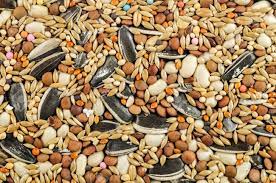
What type of bird seed attracts the most birds?
In the article referenced above (full citation immediately below), the authors examined 10 seeds commonly found in mixed bird food blends. They then offered these seeds individually in different types of feeders.
[David J. Horn, Stacey M. Johansen, and Travis E. Wilcoxen, 2014, Seed and Feeder Use by Birds in the United States and Canada, Wildlife Society Bulletin, Volume 38, Issue 1, pages 18–25.]
What birds eat black oil sunflower seeds?
It’s no surprise that black oil sunflower seeds top the list of favorite bird seeds. This bird food is well-known to attract many birds. This is the special favorite of larger finches (house finches), cardinals, chickadees, and nuthatches.
What birds eat hulled sunflower seeds?
Hulled sunflower seeds (also known as hearts or kernels) that are broken into smaller pieces (as sunflower chips) are a favorite of smaller finches including goldfinches, redpolls and pine siskins. The seeds of the niger plant (trademarked as Nyjer) and often sold as “thistle,” is similarly sought out by these same small finches.
What birds eat millet?
White proso millet bird seed is the favorite food of ground-feeding sparrows, juncos, mourning doves, and red-winged blackbirds. Unfortunately, however, millet bird seed is also the favorite of house sparrows and brown-headed cowbirds, two species that are viewed as pests by some as they can be harmful to other birds.
Bird seed filler in cheap bird seed
Of course, birds will eat many other items. But given a choice, most birds will choose sunflower seeds, Niger, and white proso millet over other options.
Cheaper mixed bird seed blends have a high volume of “filler” seed. These seeds are cheaper, as they are used in the poultry industry and available at lower cost. It is noteworthy that no backyard birds prefer red milo (sorghum) or safflower seeds. Only one bird, the common grackle, prefers cracked corn. All three of these items are commonly used in cheap bird seed mixes.
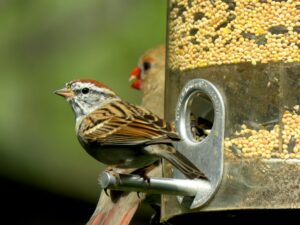
What seeds are in wild bird seed mixes, and what do birds actually like?
More information of the above article is on the Project Wildbird website (source).
The 10 types of seeds found in bird seed mixes for this study included:
Black oil sunflower
Hulled sunflower (fine sunflower chips and medium sunflower chips)
Striped sunflower
Cracked Corn
Niger
Red milo (sorghum)
Safflower
Whole peanut kernels (out of shell)
White proso millet
This study is similar, if more extensive, than one published in 1980 for the US Department of the Interior (Special Scientific Report–Wildlife No. 233) by Aelred D. Geis. It is titled: “Relative attractiveness of different foods at wild bird feeders.” (source)
Geis compared different foods to regular striped sunflower seeds and white proso millet, common items in wild bird seed mixes that most birds eat.
Geis found that, for instance, American Goldfinches preferred hulled sunflowers (whole kernels or broken chips), niger seed (“thistle”), and black oil sunflower seeds more than regular striped sunflower seeds. The goldfinches did not eat the white proso millet.
Cardinals preferred black oil sunflower seeds over other types of sunflowers, but liked sunflower seeds of all types, and would eat a wide variety of other seeds, as well, including safflower seeds.
Blue Jays liked whole peanut kernels and striped sunflowers.
House Finches like black oil sunflower seeds, preferring them twice as much as their next choices of striped sunflowers and hulled sunflowers.
White-crowned and White-throated Sparrows liked black oil sunflower seeds and white proso millet.
Song Sparrows and Dark-eyed Juncos preferred white proso millet.
So, knowing that most birds want to eat black oil sunflower seeds and white proso millet above all else, what do bird seed providers put in their wild bird seed?
Milo.
Not just milo, but other seeds that backyard birds don’t eat.
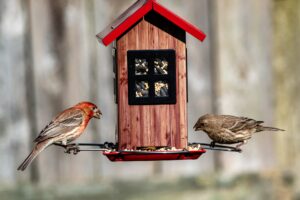
Seeds found in wild bird seed mixes that most backyard birds don’t eat:
Buckwheat
Canary seed
Cracked corn
Flax
German millet
Red millet
Japanese millet
Red milo (sorghum)
Oats hulled
Oats whole
Rape seed
Rice
Wheat
What is the best bird seed mix?
The best bird seed mix is none. Skip the commercial birdseed mixed blend and feed birds what they want!
Put one type of seed in each separate feeder!
Finches and nuthatches like black oil sunflower seeds. They prefer raised tube feeders.
Sparrows and juncos like white proso millet. They like low platform (tray) feeders or even eating on the ground.
Goldfinches and siskins like niger seed (“thistle”) in a special thistle sock.
If you want to offer your backyard birds generic mixed seed, I’d put it in a small hopper feeder or a low platform feeder. As soon as the black oil sunflower seeds are gone, though, so will be many other birds except for juncos and sparrows. I’d have a second feeder–a tube feeder–dedicated to black oil sunflower seeds for the finches, cardinals, chickadees, nuthatches and other birds.
If you have lots of quail and mourning doves, though, cheap bird seed with lots of red milo on a low platform feeder may be ideal.
A comparison of bird seed ingredients and ratios
Christopher Ingraham investigated different bird seed mixes for an article in the Washington Post (source). He went to local stores in Minnesota, including Wal-Mart, and carefully measured the seeds himself. Here’s what he found:
Wild Bird Seed Economy Mix
Black oil sunflower (none)
White proso millet 12%
Filler: 88%, including 74% red milo, some wheat and some cracked corn
Royal Wing Splendid Blend
Black oil sunflower 3%
White proso millet 18%
Filler: 78%, including 60% red milo and 18% wheat
Pennington Classic Wild Bird Feed
Black oil sunflower 17%
White proso millet 29%
Filler: 55%, including 46% red milo and some wheat
Our Family Wild Bird Seed
Black oil sunflower 14%
White proso millet 29%
Filler: 57%, including 43% red milo and 14% cracked corn
Harvest Songbird blend
Black oil sunflower 42%
Striped sunflower seeds and sunflower chips 14%
White proso millet 23%
Filler: 21%, including 14% red milo and 7% safflower
Pennington Waste Free Bird Seed
Hulled sunflower chips 52%
White proso millet 26%
Fruit and nuts 6%
Filler: 16%, including cracked corn and canary grass (NO red milo!)
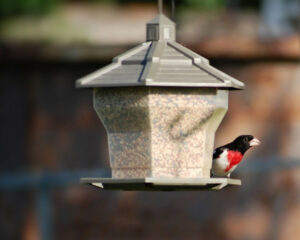
When you purchase at the store
When purchasing at the store look at the seed. The Harvest Songbird blend is nearly half (40%) black oil sunflower seeds and that plastic bag should look quite black through the transparent sections. A good product!
You should always read the ingredients. That Pennington’s Waste Free brand has no milo. And though you won’t see any black hulls of the black oil sunflower seed, you will read that its very first ingredient will be sunflower chips. A good bird seed!
If the first ingredient is milo (sorghum) move on.
|
|
|
Milo is the first listed ingredient. Don’t buy!
Click to enlarge
|
What I saw in the bird food department at Wal-Mart
I recently went to Wal-Mart to see what kind of bird foods they offered. Our yard is landscaped gravel and cement sidewalks with only a few succulents in pots. Marlene and I were looking for a no-waste/no-mess bird seed. I took lots of photos with my phone. But I must admit that I’m not any good at using my phone camera–I’m too self conscious!
My first photo is the ingredients list of a Pennington bird seed. It has very few black oil sunflower seeds and lots of milo and millet visible. My photo doesn’t show the brand, but the fact that milo is listed as the first ingredient, it must be the Pennington Classic. Don’t buy.
Another photo shows a Premium Finch Lovers Blend by 3-D Pet Products. It is sunflower kernels and niger seed. This is perfect in a tube feeder for goldfinches, house finches, chickadees and nuthatches! It was 13.8 cents an ounce, so more expensive by weight, but less than $11 for 5 pounds. Seems like a good deal.
I was interested to see Harvest Seed & Supply Mealworm Medley. It advertises as attracting bluebirds and “rarely-seen songbirds.” It might. The ingredient list starts out with black oil sunflower seed, millet, safflower seed, chipped sunflower seeds, striped sunflower seeds, peanuts, dehydrated mealworms. The final ingredient is milo. Since it is listed last, I believe that it should be the least common ingredient. I might just put out mealworms for bluebirds, though. The other ingredients are found in most mixed bird seed blends.
Harvest Seed & Supply also has a No Waste Wild Bird Food. It’s half the price of the Finch Lovers Blend. Let’s see what ingredients it has. Dehulled sunflower seeds. Evidently “dehulled” is the same as “hulled”! Millet is next, peanuts, canary seed. I can’t look through the bag to see but it must be similar to the Pennington Waste Free Bird Food. Seems a good choice for attracting a wide variety of birds for non-messy bird feeding.
Next was the 3-D Premium Nut N’ Berry. Sunflower kernels, peanuts, sunflower seed, safflower seed, pistachios, hulled pumpkin seed, dried raisins (isn’t that the definition of raisins?), and dried cranberries. Hmm, seems like a good trail mix rather than bird food! More for larger finches, grosbeaks, cardinals, and jays. The sparrows, towhees, and juncos get left out.
 |
| Seed fits in storage container to keep fresh in and pests out |
We finally ended up with the 3-D Zero-Waste Deck, Porch N’ Patio. That’s where we hung our new feeder–from our bedroom window awning over the patio sidewalk. The ingredients list is sunflower kernels, peanuts, pistachios, and hulled pumpkin seeds. That’s okay for larger finches.
We only have House Finches (and a Black Phoebe at our bird bath). We could get Lesser Goldfinches if we put up a thistle sock, but niger seed is too messy for our yard. This choice would not attract sparrows. On the other hand, it also does not attract House Sparrows. We don’t have many in the area… and would like to keep it that way, as they are a bit messy and aggressive.
 |
| Our patio bird feeder with no-mess seed |
The feeder we bought (not a large choice in San Diego in summer) was more decorative than functional, however. It was a pretty Stokes brand glass tube feeder with small tray at the base.
Unfortunately the seed is too large. Peanut and pistachio pieces get stuck in the opening and we have to unclog it.
But, hey! The few birds we do have in our yard did come to the feeder. The House Finches did tend to throw out some of the peanuts in order to get to the sunflower pieces. A ground squirrel cleaned up the sidewalk. So, no mess! Kind of. If we had tree squirrels instead of fence lizards, though, we might not be so happy.
Wrapping Up
The joy of feeding birds is a multifaceted experience, woven from a blend of factors that tap into various aspects of our human nature. Here are some key reasons why watching and feeding our feathered friends brings such delight:
Connection with Nature:
- Bringing Nature Close: Feeding birds creates a portal to the natural world, inviting these beautiful creatures into our immediate environment. Watching them flit and feed nurtures a sense of connection with the wider ecosystem, reminding us of our place within it.
- Awe and Wonder: Witnessing the intricate beauty of birds, their unique behaviors, and their captivating songs brings a sense of awe and wonder. Witnessing their resilience and the delicate balance of nature fosters a deeper appreciation for the world around us.
Nurturing Instinct:
- The Act of Giving: Caring for another living being, even in a small way, activates our innate nurturing instincts. Providing food for birds brings a sense of satisfaction and purpose, knowing we’re contributing to their well-being.
- Observing Success: Seeing birds readily eat the food we offer provides a tangible sense of accomplishment and the joy of contributing to their survival, especially during harsh winter months.
Mental and Emotional Well-being:
- Stress Reduction: Observing birdsong and their graceful movements has a calming effect, lowering stress levels and promoting relaxation. The natural world acts as a balm for the soul, providing a welcome escape from daily pressures.
- Sense of Peace: The predictability and routine of feeding birds can offer a sense of peace and stability, particularly in hectic times. Watching their antics and consistent presence can bring a sense of comfort and joy throughout the day.
- Mindfulness and Presence: Observing birds encourages us to slow down, be present in the moment, and appreciate the simple beauty of nature. It can act as a mindfulness exercise, drawing our attention to the details and wonders around us.
Frequently Asked Questions
Do wild birds know I feed them?
While wild birds may not possess human-like cognitive abilities, there’s strong evidence they associate positive experiences with specific locations and food sources. This means when you consistently offer them tasty treats in your backyard, they’ll gradually learn to recognize your feeder as a reliable source of nourishment.
Here’s how birds might develop this connection:
1. Memory and Familiarization: Birds have remarkable spatial memory and can remember landmarks and food sources for extended periods. So, after repeated visits to your feeder, they’ll begin to recognize its location and associate it with the delicious meals it provides.
2. Social Learning: Birds often learn from each other, and if other birds in their flock discover your tasty offerings, they may spread the word, leading to an increase in feathered visitors. Soon, your backyard could become a popular avian hangout!
3. Conditioning: Through consistent feeding, you create a positive association for the birds. The sight of the feeder, the sound of seeds, and the reward of a tasty snack all reinforce the link between your backyard and a reliable source of food.
What’s the best time to feed wild birds?
The best time to feed wild birds depends on several factors, including the season, species, and your goals. Here’s a breakdown to help you find the optimal feeding schedule:
Early Morning – Ideal for replenishing energy lost overnight, especially during cold winter months. Many birds forage actively at dawn, making them more likely to find your feeder quickly.
Late Afternoon – Provides another energy boost before nightfall, crucial for some species like nightingales and thrushes. Offers a quieter time for smaller birds as larger ones might be roosting.
Can birds tell if you’re watching them?
Whether birds can “tell” if you’re watching them is a fascinating question with no definitive answer. While they lack the human capacity for self-awareness, research suggests they do exhibit various behaviors that might be interpreted as responses to our presence. Here’s a closer look:
Birds are highly attuned to their surroundings:
- Vision: They have excellent eyesight, often exceeding human capabilities in terms of color perception and peripheral vision. This allows them to detect movement and subtle changes in their environment, including you observing them.
- Hearing: Their auditory senses are also exceptional, enabling them to pick up on your sounds like footsteps, talking, or even the click of a camera.
- Predation awareness: Being prey animals, birds are constantly vigilant for potential threats. Your presence, especially if sudden or loud, might trigger a cautious response.
Possible responses to being observed:
- Increased alertness: They might become more vigilant, pausing their activity to observe you or raising their heads to scan their surroundings.
- Vocalizations: Some birds might emit alarm calls or change their vocal patterns in response to your presence.
- Flight or avoidance: If they perceive a threat, they might fly away or move to a more concealed location.
- Habituation: Over time, if your presence is consistent and non-threatening, some birds might become accustomed to you and resume their normal behavior.
Related Articles
Why don’t birds come to my feeder?
What is thistle and what kind of birds eat it?
Try feeding birds orange halves


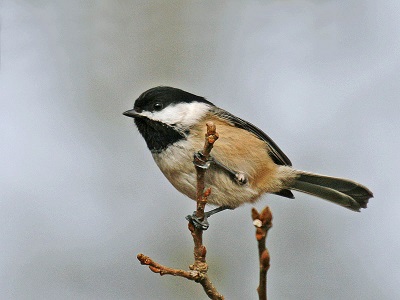
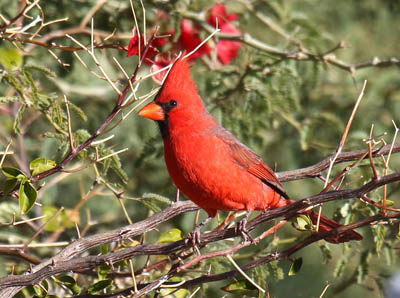
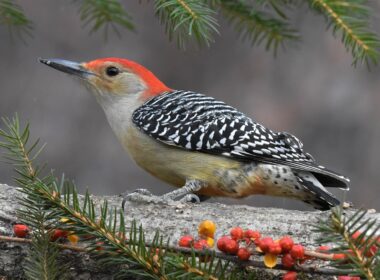
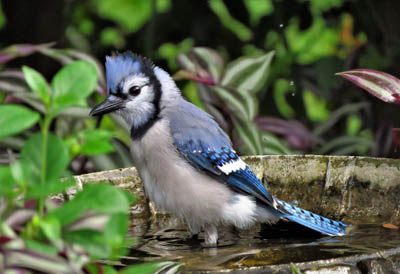
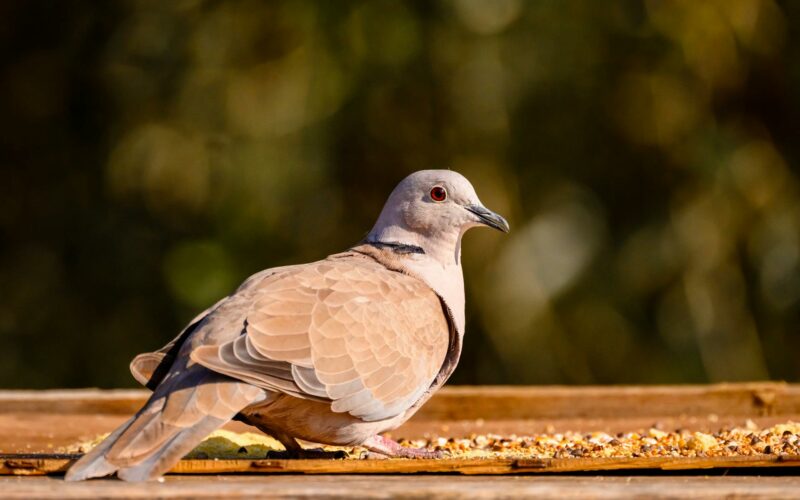
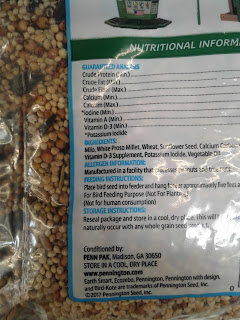
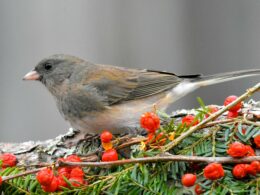
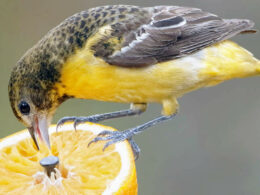
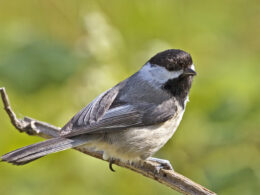
what a great article! i found it very helpful
Thanks Donna.
This is the best article about bird seed I have ever read. I have been trying to figure out how to reduce cost and waste in how I'm feeding the birds and I finally have some answers! I can't wait to try feeding more select seed and putting only one kind of seed per bird feeder. It makes so much sense! Plus that way I can see what is being eaten and who is eating it. I've saved this page and site. Thanks so much!!
I'm so glad this was useful to you!
When the garden is near the forest, it is easy to see rare birds. Since I live in town, it's hard to see many other rare birds.
Sometimes towns can provide habitat that is missing in surrounding areas. Towns often have a wider variety of trees, water, and mild weather than adjacent areas. However, this varies in each location. A new town without shade trees, or all concrete will have fewer birds, as you note.
Thank you for commenting!